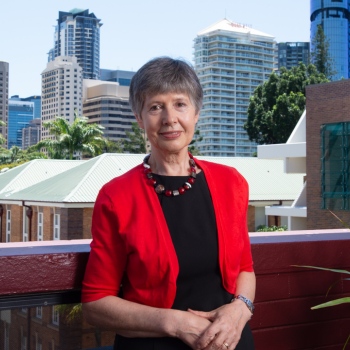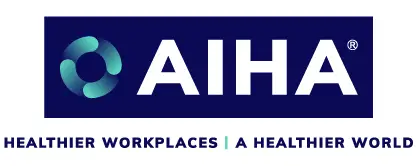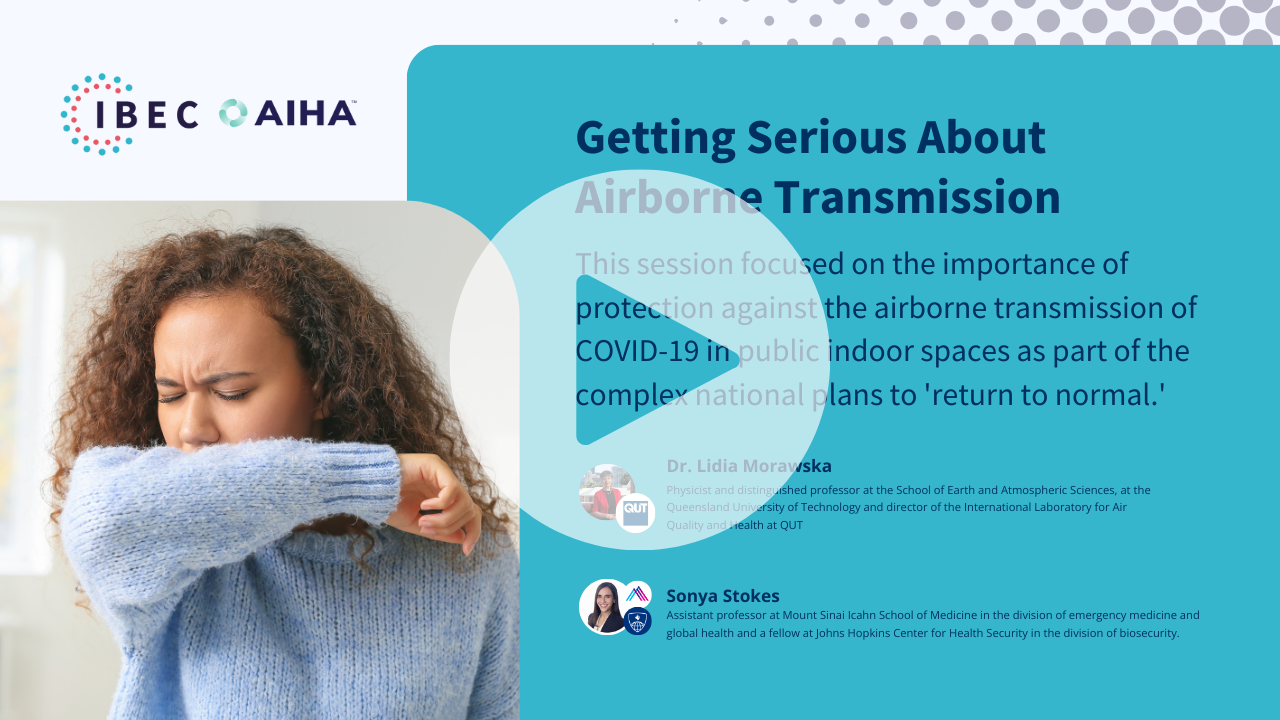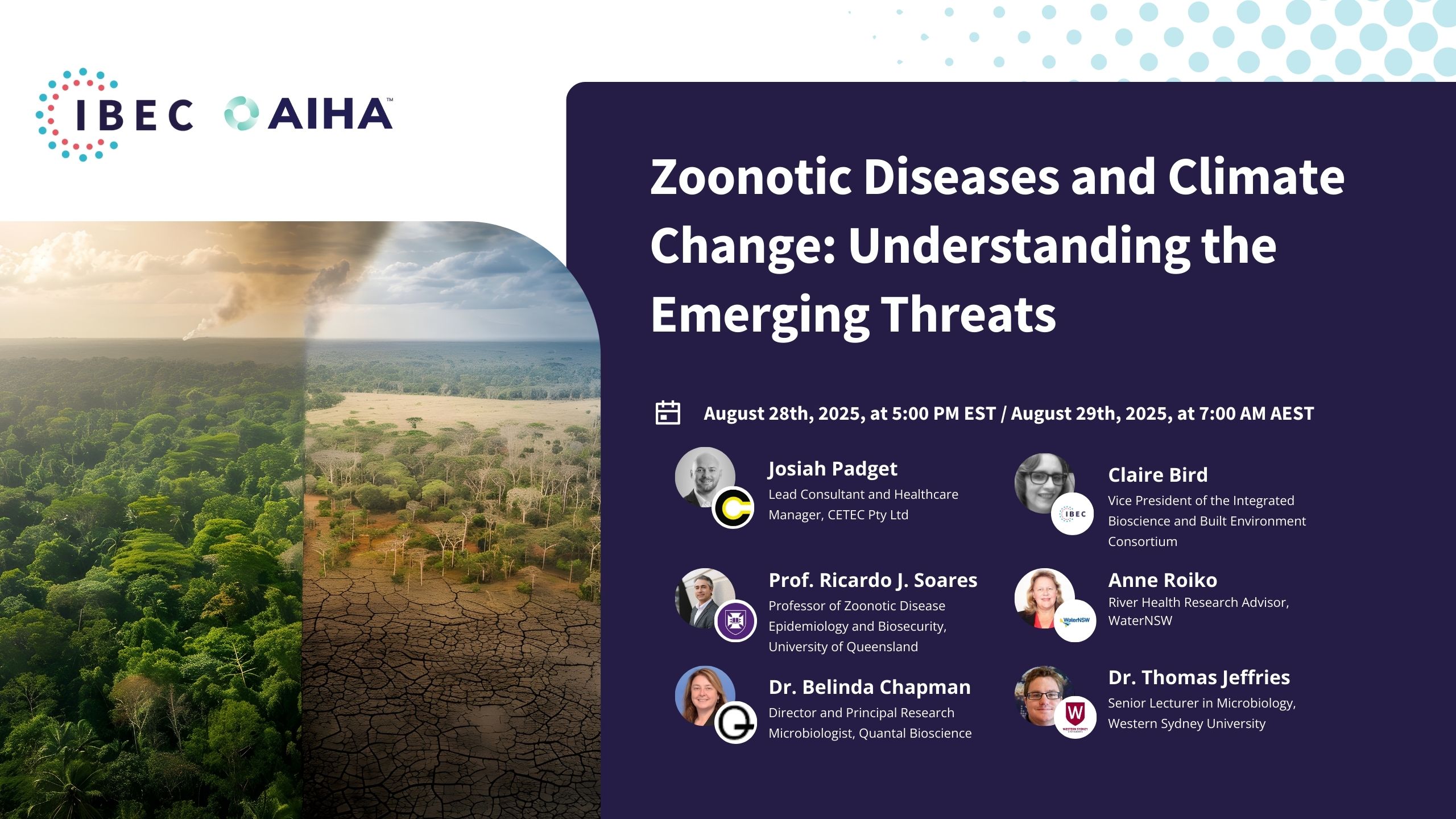Learn about the importance of protection against the airborne transmission of COVID-19 in public indoor spaces as part of the complex national plans to ‘get back to normal’
CLEAN Lessons Learned
Getting Serious About Airborne Transmission
This session focused on the importance of protection against the airborne transmission of COVID-19 in public indoor spaces as part of the complex national plans to ‘return to normal.’
Governments like Australia’s had been deploying or undergoing multi-stage plans to bring the country back to something closer to normality. However, for these efforts to be successful, they needed to have at the core an understanding of how COVID-19 spreads.
Over the previous 18 months, it was understood that most people became infected with the virus that causes COVID-19 by inhaling it from shared air. The risk was predominantly indoors.
In the conversation, they discussed some of the solutions that had been proposed to help adapt public buildings and indoor places to reduce the risk of transmission of COVID-19.
- Primary Transmission Route: COVID-19 spreads primarily through inhalation of aerosol particles.
- Importance of Ventilation: Proper ventilation is essential in combating indoor respiratory infections, not just for COVID-19 but also for other pathogens.
- Economic Impact: Poor indoor air quality has severe economic repercussions, with COVID alone costing the US approximately $1 trillion monthly.
- Need for Revised Standards: There’s an urgent call to revise building and ventilation standards to incorporate health and infection controls.
- Practical Solutions: Simple steps, such as opening windows, adjusting ventilation systems, and using indoor air purifiers, can mitigate COVID-19 risks. Additionally, measuring carbon dioxide can be a proxy for assessing ventilation efficiency.
- Hygiene Protocols: While surface cleaning (hygiene theater) gained prominence, it wasn’t always evidence-based. The emphasis should also be on mitigating airborne transmission risks.
- Ventilation Technologies: Retrofitting systems with high-efficiency filters like HEPA might be beneficial, but not every space requires it. The solution should fit the needs of the specific venue. However, indiscriminate implementation might disrupt existing ventilation systems.
- Cleanroom Standards: While cleanroom technologies are a reference point, not every indoor space requires stringent measures.
- Lack of Clear Protocols: There’s a noticeable lack of clear, standardized protocols specifically aimed at ensuring clean air in indoor environments.
- Challenge of Surface Transmission: The initial emphasis on deep cleaning and disinfection was based on older beliefs regarding transmission through large respiratory droplets.

Kenneth Martinez
IBEC’s Chief Science Officer and Board founding member
Ken is an Environmental Engineer and Industrial Hygienist with experience in leading and conducting large-scale research, managing programs in occupational safety and health and emergency response; and creating and teaching professional development courses. He has over 33 years of CDC expertise in hazardous agent exposure characterization and mitigation control practices in the manufacturing and healthcare industry. Since retiring from the CDC, he served eight years in the CBRN space as a consultant focusing on a national biodetection program. Mr. Martinez is a recognized subject matter expert in biological agents, including infectious disease and bioterrorism agents.

Claire Bird
IBEC’s Executive Secretary
Claire Bird, the new Executive Secretary at IBEC, is a passionate scientist and entrepreneur, driving healthier building standards through her laboratory management, training, and consulting expertise. Through LITMAS laboratory, she’s committed to delivering established and innovative solutions. As a dedicated advocate, Claire volunteers as an expert in indoor air quality (IAQ) across global professional bodies, emphasizing the need to protect occupants from chemical and microbiological hazards. Her mission amplifies the importance of IAQ within the industry and regulations. Moreover, she collaborates internationally, ensuring timely, relevant industry standards that align promptly with current scientific knowledge.

Dr. Lidia Morawska
Physicist and distinguished professor at the School of Earth and Atmospheric Sciences, at the Queensland University of Technology and director of the International Laboratory for Air Quality and Health at QUT
Dr. Lidia Morawska is a Distinguished Professor at the Queensland University of Technology in Brisbane, Australia, and the Director of the International Laboratory for Air Quality and Health at QUT, a Collaborating Centre of the World Health Organization.
Dr. Morawska also holds positions of Adjunct Professor, Institute for Environmental and Climate Research (ECI), Jinan University, Guangzhou, China, of Vice-Chancellor Fellow, Global Centre for Clean Air Research (GCARE), University of Surrey, UK, and is a co-director of the Australia-China Centre for Air Quality Science and Management.
She conducts fundamental and applied research in the interdisciplinary field of air quality and its impact on human health and the environment, focusing on the science of airborne particulate matter.
She is a physicist and received her doctorate at the Jagiellonian University, Krakow, Poland, for her research on radon and its progeny.
An author of over eight hundred journal papers, book chapters, and refereed conference papers, she has been involved at the executive level with many relevant national and international professional bodies. She is a member of the Australian Academy of Science and a recipient of numerous scientific awards.

Sonya Stokes
Assistant professor at Mount Sinai Icahn School of Medicine in the division of emergency medicine and global health and a fellow at Johns Hopkins Center for Health Security in the division of biosecurity.
Sonya Stokes is an assistant clinical professor of emergency medicine at Mount Sinai Icahn School of Medicine, and she is the medical director of the COVID-19 advisory team at Mount Sinai Health Partners. She was a fellow at Johns Hopkins Center for Health Security in the Emerging Leaders in Biosecurity program, and she is a member of the Council on Foreign Relations Independent Task Force on preparing for the next pandemic. Dr. Stokes received her medical degree from the University of California Davis School of Medicine, and she completed her fellowship training at Columbia University Medical Center where she also earned a master of public health specializing in health systems strengthening in resource-limited settings. She lives in New York City.
Kenneth Martinez 00:11
Welcome to the inaugural session of the C.L.E.A.N. Lessons Learned series. I’m Kenneth Martinez, the CEO of IBEC, joined by Dr. Jayne Morrow, our president. IBEC, or the Integrated Bioscience and Built Environment Consortium, bridges the science-to-application gap, ensuring safety in indoor spaces. While vaccines and human diagnostics are crucial, environmental strategies are equally important against airborne diseases like COVID-19. We focus on the nexus of people, pathogens, and buildings.
Today, we have an enlightening presentation, followed by a panel discussion with Dr. Sonya Stokes, Dr. Claire Bird, and myself.
Dr. Sonya Stokes is an Assistant Clinical Professor of Emergency Medicine at Mount Sinai and a Biosecurity Fellow at Johns Hopkins Center for Health Security. She played a pivotal role during NYC’s initial phase of the COVID-19 outbreak and served on Mount Sinai’s Best Practices committee.
Dr. Claire Bird, with two decades in the environmental sector, has worked extensively in the UK and Australia. She has helmed multiple organizations and currently leads an Australian consulting organization focusing on the built environment. Claire served as the president of the Indoor Air Quality Association and is associated with numerous other professional bodies.
Claire, please introduce our esteemed guest speaker.
Claire Bird 04:24
Thank you, Ken. I’m honored to introduce Professor Lidia Morawska. A physics graduate from Poland, she is now a global authority on airborne particulate matter and its health impacts. With over 800 peer-reviewed publications, she’s a distinguished professor at the Queensland University of Technology and collaborates extensively with the World Health Organization. Her work spans continents, including collaborations in China and the UK. She’s a beacon in the scientific community, and we eagerly await her insights on addressing airborne transmission.
Lidia Morawska 06:23
Thank you, Claire, for the introduction, and for inviting me to discuss the crucial topic of airborne infection transmission. From the outset of the pandemic, I sought to persuade both national and international health authorities of this issue. Initially, my efforts were met with resistance. However, perceptions began to change around July last year. Yet, just as progress was being made, enthusiasm waned due to the anticipated relief from vaccines. Then came the Delta variant, emphasizing that our fight against the pandemic was far from over. I want to emphasize that it’s not only about COVID-19; it’s about all respiratory infections transmitted through the air.
To level the ground, let’s clarify some terminologies. In the physics world, an aerosol is a collection of liquid or solid particles suspended in the air, while a droplet is a liquid particle. Medical definitions differ, but for simplicity, I’ll refer to these as particles. Airborne transmission is essentially the inhalation of virus-containing particles, regardless of distance from an infected person.
Tracing the acknowledgment of airborne transmission, early statements from the WHO denied its existence. These declarations were echoed globally. Over time, however, multiple scientific papers, including some I spearheaded, emphasized the airborne nature of the virus. By July, WHO recognized the emerging evidence of airborne spread but has been hesitant in its recommendations since.
Countries like the US have been more assertive. Dr. Fauci’s acknowledgment of the aerosol’s significance and the CDC’s guidelines highlight this. However, there remains a gap between acceptance and tangible action. While some countries like Germany have taken proactive measures like improving ventilation in public spaces, others lag behind.
To understand the consequences of neglecting airborne transmission, one must consider the significant number of cases and deaths that could have been avoided and the colossal economic losses incurred.
Several outbreaks have underscored the significance of airborne transmission. Cases like the Skagit Valley choir practice and the Guangzhou restaurant incident reveal how airborne transmission plays a pivotal role in infection spread. Mathematical modeling further substantiates this claim, emphasizing the importance of effective and sufficient ventilation.
Addressing the concern: is it feasible to mitigate airborne transmission during the pandemic? The answer is yes. Public awareness is paramount. Governments should emphasize the airborne nature of the virus. Simple steps like opening windows or using portable air purifiers can make a difference. Monitoring CO2 concentrations in spaces can also provide an estimate of the ventilation efficiency.
Yet, it’s essential to consider the totality of air risks when designing and operating buildings, not just airborne infections. Solutions like distributed airflow, personalized ventilation, and even adjusted occupancy can make a difference.
Regarding the economic aspect, it’s vital to understand that the cost of indoor air pollution’s impact vastly exceeds other expenditures. The price of the pandemic and other airborne diseases is staggering. Proper ventilation standards must be implemented to safeguard public health.
In closing, while COVID-19 will eventually fade from collective memory, as did the 1918 flu, it’s our hope that this pandemic catalyzes a paradigm shift in addressing respiratory infections. Just as the Cholera outbreak in the 19th century revolutionized water supply and sewage systems, may our modern battle against airborne diseases result in an unwavering commitment to ensuring clean indoor air.
Thank you for your attention.
Kenneth Martinez 42:52
Thank you, Dr. Morawska, for that insightful presentation. As an engineer, I absorbed every bit of it. At this juncture, we’ll have a 10-minute panel discussion. Please submit your questions to our stage area so we can begin addressing them. A pressing question for me is that the CDC recently mentioned that vaccinated individuals can shed the virus as much as unvaccinated individuals. Moreover, a recent study from the University of California, San Francisco (UCSF) mentioned that symptomatic vaccinated individuals have 400 times the viral load compared to asymptomatic vaccinated individuals. Dr. Morawska, how does this affect our risk assessment paradigm going forward?
Lidia Morawska 43:55
Indeed, I’ve come across such statements. The emerging evidence suggests that vaccinated individuals can shed the virus while remaining asymptomatic. This makes ventilation even more paramount. As rules are relaxed for vaccinated individuals, perhaps allowing them not to wear masks, the significance of ventilation grows. The virus will linger in the air, emphasizing the importance of proper air circulation.
Kenneth Martinez 44:35
Thank you. Dr. Stokes, you’ve been navigating this since the beginning. Could you shed light on the public acknowledgment of airborne transmission, both from a healthcare and a business perspective?
Sonya Stokes 44:53
Thank you, Ken. And my gratitude goes to Dr. Morawska for her illuminating presentation. On the front line, clarity regarding COVID-19’s transmission dynamics is vital – it directly influences how many lives we can save. The initial confusion and the persisting misunderstandings about airborne transmission aren’t just semantics; they have tangible consequences. Early in the pandemic, PPE decisions, which limited the use of N95 respirators to specific hospital areas, were made based on a limited understanding of transmission. Frontline health workers, testing patients in close proximity without sufficient protection, were at risk. As a result, many healthcare professionals fell ill.
In a business context, even today, there’s a focus on maintaining a distance of six feet between individuals as a protective measure. This neglects the fact that people might spend hours in potentially poorly ventilated spaces, leading to a false sense of safety. A clear understanding and acknowledgment of airborne transmission can empower individuals to make informed decisions about their health and safety. The research being undertaken is crucial in guiding such decisions and ensuring the well-being of all concerned.
Kenneth Martinez 47:29
Thank you, Dr. Stokes. Dr. Bird, considering your involvement in the indoor air community, how do you see the role of the indoor air quality community evolving in the context of infectious diseases? Typically, the focus has been on factors like temperature, relative humidity, and CO2 count. Can you comment on how these considerations intersect with the HVAC world?
Claire Bird 48:03
Certainly. The indoor air quality community, especially in sectors like construction that emphasize the air quality of new buildings, has largely concentrated on mold. In Australia, we had a biotoxin inquiry which spurred funding for various research programs. However, the dissemination of this knowledge across organizations remains a challenge. Current advertisements for HVAC frequently discuss adding UV lights to systems or even using essential oils. The Australian Institute of Refrigeration Air Conditioning Heating is updating their duct cleaning procedures to incorporate infection control considerations, which previously weren’t a primary focus. Surprisingly, many professionals don’t view this as an indoor air quality issue, when it clearly is. Those not already in the biosecurity space often resist broadening their horizons. The key takeaway from today’s talk was the potential of using CO2 as a proxy for assessing ventilation efficiency. This principle applies not just for infection control but for controlling other indoor pollutants. We need more integration between the communities to make such realizations commonplace.
Kenneth Martinez 51:05
Moving on, I’d like to combine a set of questions. Dr. Morawska, you touched upon risk assessment. While we recognize its complexity, how can we simplify its concepts for stakeholders like small business owners, ensuring they can incorporate these risk calculators effectively? Moreover, as our understanding deepens, how might these risk calculators evolve, and might their increased complexity hinder grassroots application?
Lidia Morawska 51:51
While the diagrams I showcased might seem intricate, the concept boils down to a straightforward spreadsheet. Users answer simple questions about their environment, and the system provides a risk analysis and corresponding recommendations. This is no more complicated than other online forms many are familiar with. Even if someone finds this challenging, basic practices like ensuring adequate ventilation can be implemented with ease. A primary step could be as simple as measuring CO2 concentration; if it’s high, more ventilation is needed.
Sonya Stokes 53:33
Emphasizing simplicity is crucial. When it comes to real-world applications, intricate modeling techniques can be cumbersome. Not only is data collection and validation challenging, but excessive technical details may diminish utility for end-users. While models are essential, a governing body that offers clear guidelines can be instrumental. Even before setting standards, such a body could guide us effectively.
Claire Bird 54:48
A clear, concise message is essential. Whether we adopt a quantitative or qualitative approach, we need a system that’s both user-friendly and rooted in science. Similar to purchasing a car, buyers trust the engineering that’s been done in the background. They don’t need to know every intricate detail, just that it works safely and effectively.
Kenneth Martinez 55:50
Dr. Bird and Dr. Morawska, considering the variants and pathogens, do we have knowledge of how real-time instruments might respond to them?
Lidia Morawska 56:01
Are you referring to real-time measurements of the virus in the air?
Kenneth Martinez 56:05
Yes, precisely.
Lidia Morawska 56:07
Currently, we don’t possess real-time measurements of the virus. The necessity is to sample, capture, and then measure it in a lab setting. If we had such a technique, it would be invaluable. In the absence of that, we rely on proxy indicators.
Claire Bird 56:26
To add, whenever a variant emerges, the genetic sequence of the virus undergoes a change. If our detection methods rely on techniques like PCR, we must ensure they stay updated. If a variant’s infectivity changes, it challenges the systems we currently have in place. For example, using CO2 thresholds to activate ventilation. How adaptable do you think our systems would be in such scenarios, Lidia?
Lidia Morawska 57:17
There’s a limit to what we can enhance. If we can maintain CO2 concentration close to the outdoor level, which is achievable in many settings, that’s our best approach. If the infectivity is still high despite this, masks remain our best defense.
Kenneth Martinez 57:53
Considering that, is using personal carbon dioxide sensors a viable risk control, especially given the lack of a clear “safe level”?
Lidia Morawska 58:05
It’s a pertinent question. While there’s no direct “safe level” of CO2 concerning infection risk, a high concentration indicates a potential problem. Ideally, indoor CO2 should be as close to the outdoor level as possible.
Kenneth Martinez 58:44
Thank you. Dr. Stokes, regarding an internal office within a large nursing school in Florida, is reducing visitors, given the lack of effective ventilation, a sufficient measure? Is this essentially a matter of maintaining social distance?
Sonya Stokes 59:11
The concerns you’ve raised are universally felt, even among frontline healthcare providers. In practice, I’ve noticed capacity limits are more effective than strictly adhering to the 6-foot physical distancing rule. That said, even with capacity restrictions, indoor spaces still pose a risk. A multi-faceted approach, informed by experts like Dr. Morawska, is vital.
Kenneth Martinez 1:00:51
On the topic of air cleaning devices, while traditional methods like filtration and ultraviolet germicidal radiation have proven their worth, what’s the consensus on emerging technologies in this domain?
Lidia Morawska 1:01:43
Many technologies exist, each with its merits. Portable Air Purifiers, for instance, are effective if used correctly. Ultraviolet light, both in ventilation systems and standalone units, can also be effective given proper air mixing. However, I’d strongly advise against technologies that introduce other pollutants. While they might deactivate viruses, the collateral damage isn’t worth it. Ionization, for example, generates secondary pollutants, making it unsuitable.
Sonya Stokes 1:03:19
I’d like to add a quick note. It’s confusing, even for healthcare professionals, to navigate through the myriad technologies available for air cleaning. We urgently need guidance to understand which technologies are effective and which are not. The situation has turned into a sort of “Wild West,” where healthcare settings are employing various and sometimes inconsistent methods, from HEPA filters to hydrogen peroxide fumigation. I would appreciate more streamlined guidance on this issue.
Kenneth Martinez 1:04:27
There’s a question about fomite and surface transmission, particularly in densely populated public transport compared to buildings. Can anyone speak to that?
Lidia Morawska 1:04:54
While I don’t recall seeing a study specifically on buses, there have been several papers indicating the relative insignificance of fomite transmission.
Claire Bird 1:05:14
Certainly, there’s research indicating that bioaerosol loading in buildings can result from the resuspension of settled particulate matter. I’m not sure if this would apply in public transport situations, where there might be high viral loads. Any thoughts?
Lidia Morawska 1:06:07
Theoretically, resuspension is possible. But the key question is whether it occurs on a significant scale, and if it’s even comparable to airborne transmission risks.
Sonya Stokes 1:06:29
As a regular subway user in New York City, my primary concern isn’t fomite transmission. When you’re crowded with people, some of whom may not be wearing masks, the risk of airborne transmission seems far greater.
Kenneth Martinez 1:06:52
Dr. Stokes, given the surge of the Delta variant and stories of hospitals reaching capacity, do you feel you have an adequate supply of personal protective equipment?
Sonya Stokes 1:07:27
The availability of PPE varies by health system, and there’s a lack of transparency about the levels of supply. We’re told supplies are sufficient, but without clear data, it’s hard to be certain. Additionally, there’s still no uniform guidance on the proper use of PPE, which further complicates the issue.
Kenneth Martinez 1:09:25
Dr. Morawska, can one “quanta” be equated to a specific number of viral microorganisms, like say, 10^3 per cubic meter?
Lidia Morawska 1:09:36
Yes, a “quanta” can technically be translated into a concentration of viral particles in the air. However, it’s essential to remember that “quanta” are used in the context of infection transmission risk. While the concentration can be translated, it doesn’t necessarily mean much without that context.
Kenneth Martinez 1:10:56
Thank you. Dr. Bird, how can one define the potential positive mitigative impact of building upgrades on risk? And how can one integrate clean air protocols into specific tactical needs, such as capacity limits in a conference room?
Claire Bird 1:11:44
Modeling could be one approach to assess the impact of building upgrades, such as the addition of a HEPA filter. Challenge tests could also be conducted, where a specific size range of particles is introduced and measured downstream of the system. Translating this into infection risk would be complex but possible. As for specific tactical needs, those could potentially be integrated into the modeling or challenge tests to assess the overall effectiveness of the upgrades.
Kenneth Martinez 1:12:47
So, looking at integrating clean air protocols specifically for tactical needs, we’ve seen many cleaning surface protocols in places like hospitals. But where do we stand with clear air protocols?
Claire Bird 1:13:11
I haven’t come across any clear guidelines or protocols focused solely on clean air.
Lidia Morawska 1:13:20
Yes, we don’t have measures or protocols that mandate specific air concentrations.
Sonya Stokes 1:13:27
It’s interesting because, when it comes to hygiene, surface transmission measures were implemented even when they weren’t backed by strong evidence. The visibility of cleaning actions, like wiping surfaces, made them more approachable than unseen air cleaning measures. However, why not give equal importance to reducing airborne transmission risks?
Kenneth Martinez 1:14:54
Absolutely, Dr. Stokes. Another question for Dr. Bird and Dr. Morawska: would retrofitting mainstream ventilation systems with cleanroom technologies, such as HEPA filters, be effective? Particularly since clean rooms use particle counters to define cleanliness levels.
Lidia Morawska 1:15:29
Not every interior space needs to be as clean as a cleanroom. While high-efficiency filters are beneficial, simpler media filters can also effectively remove particles from the air. It’s about selecting the right technology for the space.
Claire Bird 1:16:11
Moreover, adding high-efficiency filters may impact the overall performance of some ventilation systems. There are building operation tools, like the WELL building standard, which assess the health of indoor environments. Many technologies from these tools could be used to control infection.
Kenneth Martinez 1:18:08
Thank you, Dr. Bird. One final question: was the early emphasis on deep cleaning based on protocols designed for gastro outbreaks?
Lidia Morawska 1:18:30
I believe it was. The emphasis was on large respiratory droplets settling on surfaces. It’s an old belief.
Sonya Stokes 1:18:56
From a healthcare perspective, when dealing with an unknown, the highest level of protection is usually implemented. This should have been the case for all modes of COVID-19 transmission. But the focus seemed to be only on surface transmission.
Kenneth Martinez 1:19:48
Thank you, Dr. Stokes. To summarize today’s discussion: COVID-19 primarily spreads via aerosol particles, making ventilation crucial. Economic costs of poor indoor air quality are vast, and we need health-focused ventilation standards. While vaccination and diagnostics are essential, ventilation is a complementary strategy that shouldn’t be ignored. Join IBEC to help develop more educational resources like this. Our future stages will cover bio surveillance and detection, along with an assessment of vulnerable worker populations. Thank you all for your participation and insights today. Good evening.
Sponsor Spotlight

American Industrial Hygiene Association (AIHA)
AIHA is the association for scientists and professionals committed to preserving and ensuring occupational and environmental health and safety (OEHS) in the workplace and community. Founded in 1939, we support our members with our expertise, networks, comprehensive education programs, and other products and services that help them maintain the highest professional and competency standards. More than half of AIHA’s nearly 8,500 members are Certified Industrial Hygienists, and many hold other professional designations. AIHA serves as a resource for those employed across the public and private sectors and the communities in which they work.

IEQ Global Alliance(AIHA)
The mission of IEQ-GA is to provide an acceptable indoor environmental quality (Thermal environment, sound, light and indoor air quality) to occupants in buildings and places of work around the world and to make sure the knowledge from research on IEQ gets to be implemented in practice.

Association of Biosafety For Australia and New Zealand (ABSANZ)
ABSANZ – the Association of Biosafety for Australia and New Zealand – was formed to share knowledge about biosafety and biosecurity in an open, collaborative, and informative way. Its purpose is to protect people, the community and the environment through advancing knowledge in biosafety and biorisk management.
Have a question about the event?
Connect with IBEC experts directly! Drop your queries below, and let's further the dialogue on preventing the spread of infectious diseases.


